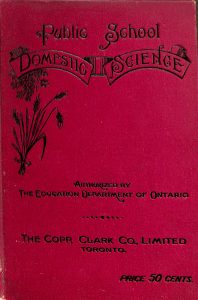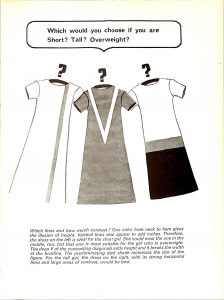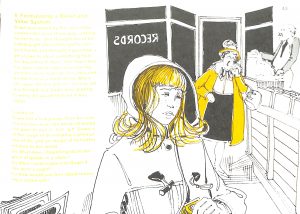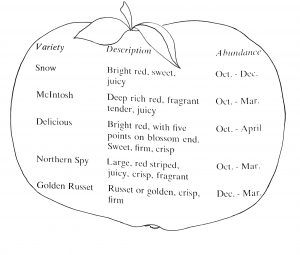This month, the OHEC display features the history of home economics in Ontario secondary schools.
The home economics movement in Ontario began during the late 19th and early 20th centuries. At the forefront of the movement was Adelaide Hoodless, who became a champion for both women’s education and household issues after her newborn son died of foodborne illness. In 1898, Hoodless penned the book Public School Domestic Science, which became the first home economics textbook in Ontario and a mandatory part of the high school curriculum in 1902. In her book, Hoodless describes home economics – known then as domestic science – as a way to help students learn the fundamental principles of correct living.
 Early home economics courses were intended for young women, and were meant to work alongside an academic curriculum. By 1912, home economics was described by the Ontario Department of Education 1912 Bulletin as both a training course for home activities and a way for girls to gain “a good English education”. Subjects of study ranged from topics in Household Science itself (comprised of subjects such as Cookery, Hygiene, Household Emergencies, Bacteriology, Sewing and Handicrafts), to academic subjects including Anatomy and Physiology, Arithmetic, Civics, Chemistry and Laboratory Work, English, Freehand Drawing, French, History, and Geography. Women often used home economics courses as a gateway to university education, such as the Household Science Program at the University of Toronto founded by Lillian Massey Treble in 1906.
Early home economics courses were intended for young women, and were meant to work alongside an academic curriculum. By 1912, home economics was described by the Ontario Department of Education 1912 Bulletin as both a training course for home activities and a way for girls to gain “a good English education”. Subjects of study ranged from topics in Household Science itself (comprised of subjects such as Cookery, Hygiene, Household Emergencies, Bacteriology, Sewing and Handicrafts), to academic subjects including Anatomy and Physiology, Arithmetic, Civics, Chemistry and Laboratory Work, English, Freehand Drawing, French, History, and Geography. Women often used home economics courses as a gateway to university education, such as the Household Science Program at the University of Toronto founded by Lillian Massey Treble in 1906.
During the 1950s and 60s, the postwar boost in the North American economy shifted the focus of home economics towards consumer education. Buying food became a major focus of textbooks like Home Economics 1. Students learned “Shopping Cart Know-How”, or how to buy groceries on a budget while also paying attention to things like nutritional value, flavor, and shelf life.
Another major topic of commodification was the home. Textbooks such as House and Home (1968) discussed the different types of homes available in Ontario, the benefits of renting, buying, or building a home, how to finance a home, and how to renovate and decorate it.

A page from Food and Textiles (1964) encourages girls to choose dress patterns based on their body type.
Textiles were also a major part of the home economics curriculum. Books such as Food and Textiles (1965) not only taught girls how to sew and how to care for fabrics, but also included chapters on clothing and appearance. Women were taught to dress based on body type, and to conceal their “flaws” in height or weight by wearing clothes with certain patterns.
In 1973, Ontario renamed home economics as Family Studies. The Ministry of Education acknowledged that the roles of family members were changing, and that both boys and girls needed to learn basic skills that contribute towards family living. While textbooks still taught cooking and sewing, they also taught self-image, how to make friends, and how to deal with frustrating emotions. Books like This Is the Life! (1977) taught students how to develop personal values, and covered topics ranging from dating and sexual identity to how to navigate conflicting values with parents.

This page from This is the Life! (1977) asks students how they would react if they saw friend shoplifting.
Today, Ontario high school students at some schools can take family science as an elective under Social Sciences and Humanities. The courses offered emphasize family, school, and personal relationships.
These books will be on display in the glass table on the ground floor of the OISE Library through the end October. Also stop by to check out some classic home economics recipes!

